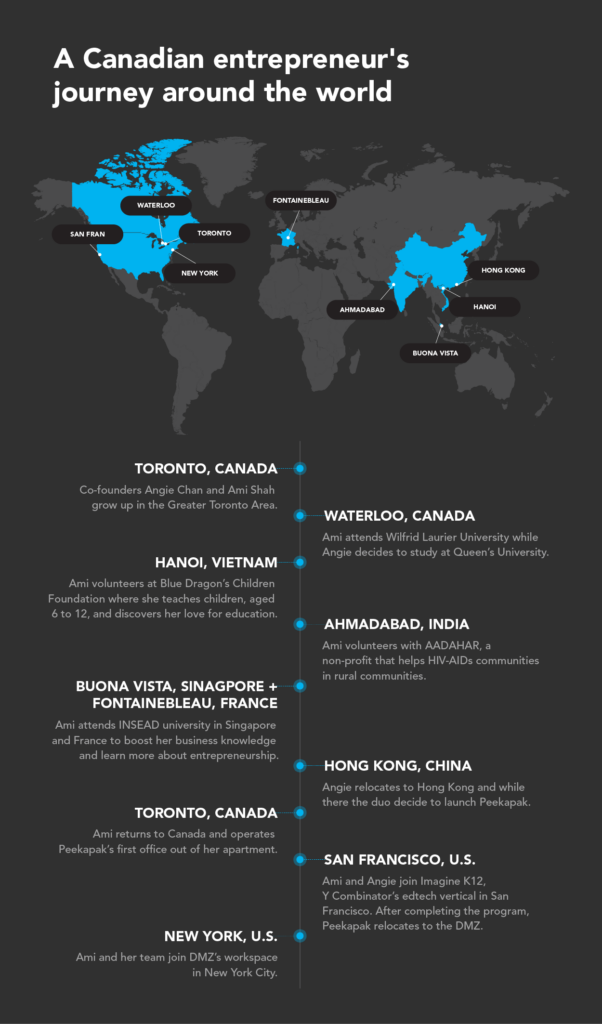Life after an acquisition can be complicated.
For most founders, the possibility of landing a big exit is a good thing. It usually means a decent amount of cash and, in most cases, the chance to stick around as an employee or consultant long after the contract ink has dried.
While some end up missing the hustle and bustle of entrepreneurship, many find that working at a big company—after years of living the startup life—gives them time to regroup and tap into resources they could only have dreamed of when they were going at it alone.
No matter the outcome, the decision to sell a company can be an intensely personal and a difficult one to make. Robleh Jama, DMZ alumni and founder of Toronto-based app studio Tiny Hearts, knows the process all too well. The entrepreneur’s startup was purchased by Shopify in 2016.
After the buyout he and a few of his colleagues stayed on to join Shopify’s special project department where they now make experimental apps for new audiences. At the time of Tiny Hearts’ acquisition, Jama’s small, yet thriving, company had nine full-time employees and three part-time associates.
Before Shopify approached him about a potential acquisition he had never really considered selling the business. “It wasn’t really an idea I thought about,” he says.
His plan was to always grow with the company long into the future but as time went on, he noticed that scaling it would take more resources than his team had at their disposal. Shopify—an Ottawa-based company with offices in Toronto, Montreal, Waterloo and San Francisco—had connections around the globe to push his ideas to the next level.
“The acquisition was very organic,” he said. “[Shopify and Tiny Hearts] started off as a working relationship first and then grew from there. It was the best way to do it.”
Not everyone will find themselves in the same situation as Jama, but there’s nonetheless a few crucial things entrepreneurs should understand before taking an all-out company buyout, he explains.
Here’s his advice for entrepreneurs considering an exit and what they should know before signing on the dotted line.
Get your company ready by doing good work
A big payoff should never be the end goal for any entrepreneur, but if you’re looking to partner with or be acquired by another company you should make sure to create something of value on a regular basis, he says.
“It all starts with and ends with producing great work,” he explains. “You’ve got to think what value does a company want or look for. It’s better to think about it that way instead of reverse engineering an acquisition. That won’t work,” he explains.
At Tiny Hearts, creating great products meant making sure his company always stayed on top of new trends in the mobile industry and applied them whenever possible to upcoming projects. It also helped Jama, he admits, that he was personally invested in learning as much as he could about mobile-based applications in his free time.
Another piece of advice? Make sure to network with as many people in your industry as you can and stay grateful. “We met people at the DMZ that are still friends of mine to this very day and connected me with other people in the field.”
Wait for the right partner
Just because a company makes an offer doesn’t mean you have to take it, he explains.
Jama and his team worked with Shopify on several projects beforehand and were well acquainted with the company’s products and, more importantly, how they could help each other elevate the work they were already creating.
He also knew how he would personally fit into its company culture as an employee. A fact that he says founders shouldn’t be too quick to overlook. “I knew what they were like. I don’t think I could work at a company that wasn’t Shopify. I was looking to level up and learn to build products at scale and they were the ones that could do it.”
Not to mention that he’s also happy with the work he’s doing. Any role you or your team take on post-acquisition should be discussed in detail before any contracts are signed, he explains.
“Working at Shopify is like a honeymoon that doesn’t end because the team I work with is autonomous and doing what we used to do at Tiny Hearts—pumping out mobile products. We’ve been given the resources to do what we’re most passionate about so we can just focus on creating innovative and experimental products.”
Seek out legal help ahead of time
There’s no shame in asking for help, especially if it involves money. Exits can mean a host of new problems, which can sometimes include doling out money or company shares to employees and should be taken seriously.
The best thing for companies to do is find someone who can help lay everything out in black and white and take emotions out of the picture, he says. “Find someone you trust and go from there.”
Last, but not least: Do your homework
Jama and Shopify executives made sure the buyout process went slowly. It took almost a year between initial talks to a contract signing.
“The idea was floated, casually, when we started working together, but we didn’t want to rush into. We said let’s continue to work together to see how it goes. After we worked with the team on an app called Frenzy we realized that Shopify was what Tiny Hearts could become if it were on steroids and were on board.”
Luckily over the years Shopify had acquired several local companies before Tiny Hearts, which made the process that much easier for Jama and his team. “Shopify had done this a handful of times of times so they made the process super smooth from the conversation to getting the deal done to transitioning, but we made sure to talk to people [clients, staff, industry professionals].”


